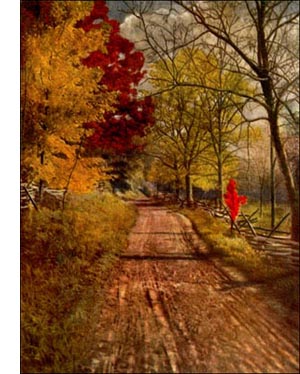Live Oak Tree
 Live Oak (Quercus Virginiana, Mill.)-Evergreen tree, 50 to 75 feet high, with thick trunk and horizontal limbs of great length forming a low, spreading dome, like an old apple tree. Often shrubby. Bark reddish brown, scaly, with shallow fissures; twigs rigid, slim, hoary at first. Wood light brown or yellow (sap wood nearly white), close grained, lustrous, compact with hardly distinguishable annual rings, heavy, tough, strong, durable, easy to split, hard to work. Buds globose, brownish, small. Leaves evergreen, leathery, elliptical or oblanceolate, entire, rarely wavy margined, and spiny tipped above the middle, 2 to 5 inches long, dark green above, paler beneath, brownish yellow in late winter, falling when new leaves appear. Flowers in March, April; staminate in hairy catkins; pistillate 3 to 5-flowered on long spikes with bright red stigmas. Acorns annual, brown, stalked,, pointed, 1 inch long, in thin cup with tapering base and small, closely appressed scales; nut sweet, 1/3 to 2/3 of it embraced by the cup. Preferred habitat, dry sandy soil near the coast. Distribution, islands and coast from Virginia to Florida, west to Mexico, and in Lower California. Uses: Superb avenue and ornamental tree in the South. Grows rapidly and is easily transplanted. Lumber better in all respects than that of Quercus alba, even.
Live Oak (Quercus Virginiana, Mill.)-Evergreen tree, 50 to 75 feet high, with thick trunk and horizontal limbs of great length forming a low, spreading dome, like an old apple tree. Often shrubby. Bark reddish brown, scaly, with shallow fissures; twigs rigid, slim, hoary at first. Wood light brown or yellow (sap wood nearly white), close grained, lustrous, compact with hardly distinguishable annual rings, heavy, tough, strong, durable, easy to split, hard to work. Buds globose, brownish, small. Leaves evergreen, leathery, elliptical or oblanceolate, entire, rarely wavy margined, and spiny tipped above the middle, 2 to 5 inches long, dark green above, paler beneath, brownish yellow in late winter, falling when new leaves appear. Flowers in March, April; staminate in hairy catkins; pistillate 3 to 5-flowered on long spikes with bright red stigmas. Acorns annual, brown, stalked,, pointed, 1 inch long, in thin cup with tapering base and small, closely appressed scales; nut sweet, 1/3 to 2/3 of it embraced by the cup. Preferred habitat, dry sandy soil near the coast. Distribution, islands and coast from Virginia to Florida, west to Mexico, and in Lower California. Uses: Superb avenue and ornamental tree in the South. Grows rapidly and is easily transplanted. Lumber better in all respects than that of Quercus alba, even.The evergreen live oak of the South is one of the handsomest of all our native trees in cultivation. Specimen trees in New Orleans, Charleston and other cities certainly challenge the observer to mention a more perfect example of all that is to be desired in tree form. The dome is low, but exceedingly broad, often spreading to twice its height and more. The trunk breaks near the base into horizontal limbs of incredible length and size. It seems as if the weight of these great arms must split the trunk, especially under the force of the wind. But the fibre of the wood is equal to resisting the strain put upon it.
The leaves are not as showy and beautiful in form as many Northern oaks. They are plain dull green beneath, lustrous above, and they last all winter until the new leaves appear in the spring. The acorns are dainty and dark brown, set in a hoary longstemmed, top-shaped cup. They are a profuse crop, and very sweet and pleasant to taste. The Indians gathered them "to thicken their venison-soop" with, and also cooked them in other ways. "They likewise draw an Oil, very pleasant and wholesome, little inferior to that of almonds." So wrote Mark Catesby, a century and a half ago.
Live-oak timber ranks highest among the white oaks. Shipbuilding depended upon it in this country until the era of steel construction. Reservation of tracts of these trees in western Florida for the use of the navy was made in the early days. "Knees of oak" still brace the sides of vessels, if they can be obtained. The beauty of the wood when polished would make it in great demand for furniture and for decorative purposes, except that it is extremely difficult to work, and it splits easily when nailed. The short trunk prevents the getting out of timbers of large size.
As an avenue and shade tree the live oak deserves especial attention. It grows rapidly and is easily transplanted. It is not particular as to soils. The trees are becoming scarce in the wild. They should be saved for the landscape's sake and planting should go steadily on. To our Northern poet, these trees
"Stand like Druids of old, with voices sad and prophetic;
Stand like harpers hoar, with beards that rest on their bosoms."
Live oaks without their draperies of moss would lose much of their charm. However, there is a great difference of opinion as to the beauty of the moss. It generally looks well in a picture, but some people think its grey straggling clusters give the oaks an unkempt and uncomfortable look, as if a parasite were choking its host.